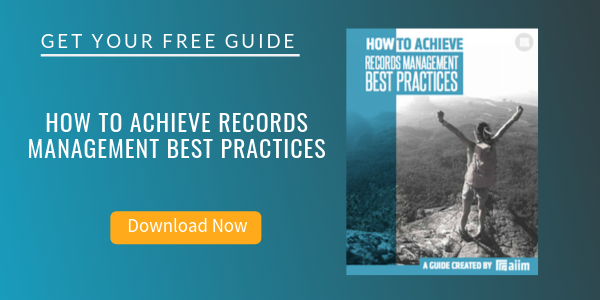
Records Management in the Intelligent Information Era
Electronic Records Management (ERM)
Records management has traditionally been significantly focused on compliance. Compliance is important; to be sure; the more highly regulated an organization is, the more important compliance is. Every organization has to comply with something, even if it’s just tax and personnel regulations. And it’s complicated – every year seems to bring more laws and regulations, not less.
As a reflection of this, in the original AIIM Electronic Records Management course, we identified 4 business drivers, and the first one listed was compliance (along with continuity, effectiveness, and efficiency). But while compliance is important, it’s insufficient as a business driver. Compliance doesn’t get management excited and eager to pour resources into it until there is a problem – and once the problem goes away, so does the focus and availability of resources. We argued in the AIIM 2019 State of the Industry – Content Services that “[information management] is better sold indirectly – as a byproduct of automation and customer experience – than head-on.”
Moreover, records managers often lament that they “don’t have a seat at the table.” In part, this is because too many records managers become known as the people that take things away or the people who say no. Some of this is necessary – compliance sometimes does mean taking away records and disposing of them, for example. But a lot of the issue is that the “table” is reserved for those most involved in helping the organization fulfill its mission and meet its goals and objectives. Consider that in recent AIIM research, 45% of organizations say their C-level executives are “not engaged at all” or only “somewhat engaged” when it comes to managing information effectively.
In the age of Intelligent Information Management, records management has to be about more than compliance. It has to be about supporting the goals and objectives of the organization. It has to be about making the organization more efficient and more effective, while still ensuring that compliance and risk are addressed appropriately.
So, if you’re a records manager, what is to be done?
1) Position Records Management as a Business Enabler
First, records managers need to position themselves as business enablers. Records managers understand the business and the business processes – they have to, in order to effectively manage the records generated by the business and those processes. Many records managers also work closely with other information management disciplines such as privacy and data protection, information security, e-discovery, capture and document imaging, etc. In short, records managers understand the power of effective information organization, access, and management today…and over time.
This means that records managers can, and should, work to identify with specificity the business value that effective records and information management bring to the organization. Management wants metrics that are SMART – specific, measurable, achievable, relevant, and time-bound. Financially quantifiable metrics, in particular, are much more compelling to senior management than vague assertions of value (or that historic focus on compliance).
It also means that records managers need to understand their organizations: their mission, their business context, their operations, and operating cycles, and how they know when they are successful. And it means records managers need to understand business generally: how to make a business case, how to read a balance sheet, how to manage a project, and how to effect change.
2) Put the Digital in Digital Recordkeeping
The overwhelming majority of records today are digital-born and come from a variety of sources and systems. Records managers need to be very comfortable with technology and with having discussions with IT about things like the technology environment, system lifecycles, etc. The IT world is so broad that even an IT professional has to specialize, but at a minimum records managers should develop a basic understanding of the following technologies:
- Analytics and machine learning
- Workflow and process automation
- Privacy and data protection, including privacy by design (and, by extrapolation, RM by design!)
- Information management solutions and repositories and their key capabilities
- Collaboration tools and where/how they store information
3) Streamline and Automate
Get comfortable with automation. In that same AIIM research report, 73% of the respondents agreed that automated classification is the only way to be able to keep up with the volumes of information organizations have to deal with. This means learning to apply and leverage automation in support of key records management tasks:
- Declaration and Classification of Incoming Information: Users don’t want to do it, and aren’t trained to do it, and simply can’t keep up with it at the volume and growth rate most organizations are experiencing. The only realistic solution is to classify incoming information automatically. High performing organizations said they had automated the ingestion of 55% of the information coming into the organization.
- Metadata Capture and Remediation: Again, users are the problem with metadata more than the solution. We can automate metadata capture at the time information is captured; we can also correct missing or incorrect metadata, at speed and at scale. Fully 70% of high-performing organizations are leveraging analytics and machine learning to automate metadata extraction; less than 4% of low-performing organizations are doing so.
- Protect Sensitive Information: This means leveraging rules, workflow, and analytics to identify potentially sensitive information, detect the capture of and access to that information, and ensure it is safeguarded against inadvertent or intentional loss. With the increased focus on privacy throughout the world and in nearly every industry sector, organizations cannot afford to do this at the “speed of paper.”
- Disposition (especially of ROT): This may be the lowest of the low-hanging automation fruit. It’s a pretty simple matter to identify all the information that hasn’t been accessed in 10+ years, and that doesn’t appear to be records or subject to legal or other holds, and then to delete it.
Records management in the Intelligent Information Management era is about helping the organization be more successful. Records managers who recognize this, and who can sell the value of their program to senior management, will be positioned to make a significant and lasting impact at their organization.



